
Hamburg Hauptbahnhof, or Hamburg Central Railway Station in English, is the main railway station of the city of Hamburg, Germany. Opened in 1906 to replace four separate terminal stations, today Hamburg Hauptbahnhof is operated by DB Station&Service AG. With an average of 550,000 passengers a day, it is Germany's busiest railway station and the second-busiest in Europe after the Gare du Nord in Paris. It is classed by Deutsche Bahn as a category 1 railway station.

Dresden Hauptbahnhof is the largest passenger station in the Saxon capital of Dresden. In 1898, it replaced the Böhmischen Bahnhof of the former Saxon-Bohemian State Railway, and was designed with its formal layout as the central station of the city. The combination of a station building on an island between the tracks and a terminal station on two different levels is unique. The building is notable for its train-sheds, which are roofed with Teflon-coated glass fibre membranes. This translucent roof design, installed during the comprehensive restoration of the station at the beginning of the 21st century, allows more daylight to reach the concourses than was previously possible.

Dresden-Neustadt station is the second largest railway station in the German city of Dresden after Dresden Hauptbahnhof and is also a stop for long-distance traffic. It is the junction for rail traffic on the northern side of the Elbe. It was built in 1901, replacing the Leipziger Bahnhof, which was opened in Leipziger Vorstadt in 1839, and the Schlesischen Bahnhof, which was opened in 1847. The station building in the district of Innere Neustadt was built in the monumental style that was typical of the time, underlining its importance as a stop for long-distance services.

The Berlin Stadtbahn is the historic east-west elevated railway of Berlin. It runs from Ostbahnhof in the east to Charlottenburg in the west, connecting several of the most major sights of the German capital. The line is protected cultural heritage since 1995. It is often defined more simply as the slightly longer route between Ostkreuz and Westkreuz, although this is not technically correct.
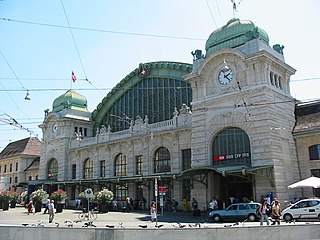
Basel SBB railway station is the central railway station in the city of Basel, Switzerland. Opened in 1854, and completely rebuilt in 1900–1907, it is Europe's busiest international border station. Basel SBB is owned by the Swiss Federal Railways (SBB CFF FFS). The other major railway station is Basel Badischer Bahnhof, operated by the German railway company Deutsche Bahn, on the north side of the Rhine from the city centre.

Berlin-Spandau station is a Deutsche Bahn station in the Berlin district of Spandau on the south-western edge of the old town of Spandau. The railway junction station is one of the 80 stations classified by Deutsche Bahn as a category 2 station. It has the longest train shed in Germany.
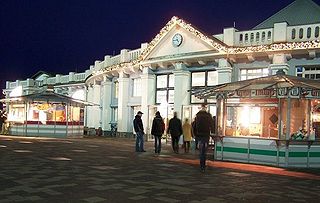
Rostock Hauptbahnhof, also Rostock Central Station IATA code "RTK"(from 1896 until the turn of the 20th century called Rostock Central-Bahnhof), is the main railway station in the German city of Rostock. It is situated well to the south of the city centre, to which it is linked by tram. The station was opened in 1886 by the Deutsch-Nordischer Lloyd, operating a combined railway/ferry line to Nykøbing Falster in Denmark. The station was expanded in 1913 and 1922, but was heavily damaged in World War II. The importance of the traditional route to Hamburg and Copenhagen diminished after the post-World War II division of Germany, with long-distance services instead focusing on cities within the German Democratic Republic. Electrification reached the station in 1985. After German reunification, the station was extensively modernised.

Erfurt Hauptbahnhof (Erfurt Hbf) or Erfurt Central Station is the central railway station at Erfurt in Germany. It is an important junction on the German rail network, served by numerous local and long-distance rail services. Immediately north of the station is Erfurt's city centre. The station was used by approximately 12.5 million passengers in 2006, an average of about 34,000 per day. The station lies on the Thüringer Bahn, which connects Halle to Bebra. It is served also by the Erfurter Bahn.
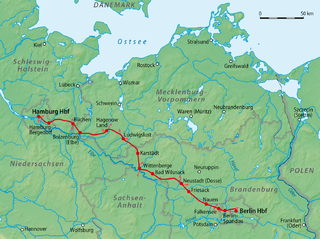
The Berlin–Hamburg Railway is a roughly 286 km (178 mi) long railway line for passenger, long-distance and goods trains. It was the first high-speed line upgraded in Germany to be capable of handling train speeds of over 200 km/h (120 mph).

The Hamburg-Bergedorf railway opened in 1842 is one of the oldest lines in Germany and was the first railway line in Northern Germany. The 16.5 km long line was extended to Berlin in 1846.

The Berlin–Lehrte railway, known in German as the Lehrter Bahn, is an east–west line running from Berlin via Lehrte to Hanover. Its period as a separate railway extended from its opening in 1871 to the nationalisation of its owner, the Magdeburg-Halberstadt Railway Company on 1 July 1886. The company's Berlin station, the Lehrter Bahnhof was finally torn down in 1958.
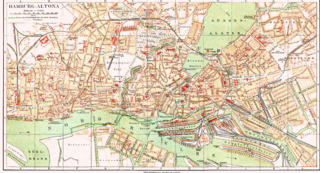
The Hamburg-Altona link line is a railway line in Hamburg, Germany. Nowadays, it connects the lines from the north and northwest of Hamburg and Altona station with Hamburg Hauptbahnhof and the lines to the southwest, south and east. Initially designed as a freight line only, it is now one of the busiest lines in Germany. It includes the suburban tracks of the Hamburg Stadtbahn, originally the core of the Hamburg S-Bahn.
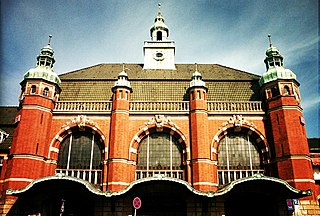
Lübeck Hauptbahnhof is the main railway station serving the Hanseatic city of Lübeck, in the German state of Schleswig-Holstein. It is a through station at the western edge of the city centre. With around 31,000 travelers and visitors each day, Lübeck Hbf is the busiest of all the railway stations in Schleswig-Holstein. It is classified by the Deutsche Bahn as a category 2 station.
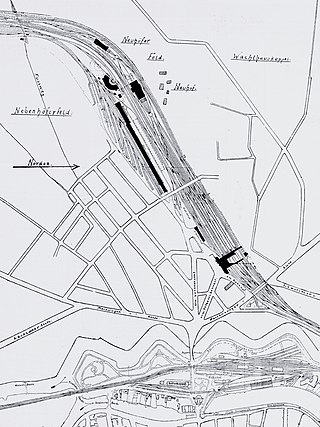
The Lübeck-Büchen Railway was a German railway company that built railway lines from Lübeck to Büchen and to Hamburg in the 19th century.

Eberswalde Hauptbahnhof is historically the most important and now the only remaining station in the city of Eberswalde in the German state of Brandenburg. It was opened in the summer of 1842 outside the then city limits on the Berlin–Szczecin railway. The city fathers of Eberswalde did not want a modern railway in their city, so the station was built three kilometres west of the city centre in a wooded area where the Westend district is today.

The Hamburg freight rail bypass is a railway line in the German city of Hamburg. It runs from Hamburg-Eidelstedt via Hamburg-Rothenburgsort to Hamburg-Harburg and connects the long-distance railways approaching Hamburg, bypassing the link line and the railway junctions on the approaches to Hamburg-Altona station and Hamburg Hauptbahnhof. The line is mainly used for rail freight.
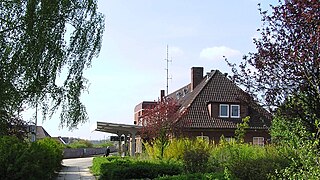
Büchen station is a railway junction in Büchen in the German state of Schleswig-Holstein. About 4,000 passengers embark or disembark each day.
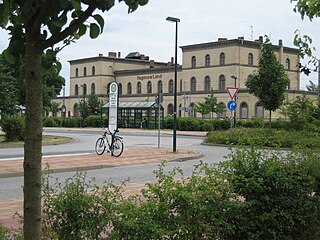
Hagenow Land station is a railway junction in Mecklenburg-Vorpommern, which was opened on 15 October 1846. It is located about 2.5 kilometres from the centre of the small town of Hagenow. It is classified by Deutsche Bahn as a category 5 station.
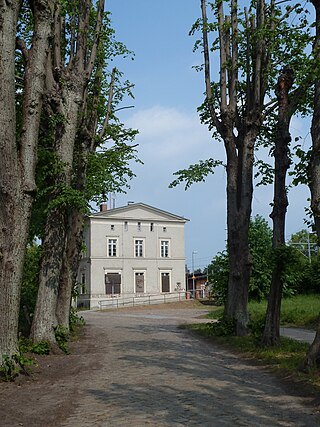
Grabow (Meckl) station is located on the Berlin–Hamburg railway in Grabow in the south west of the German state of Mecklenburg-Vorpommern. Together with four other stations, which also opened on 15 October 1846, it is the oldest station in the state. The Neoclassical entrance building, which dates from the opening of the line, and some other buildings in the station area are heritage-listed.
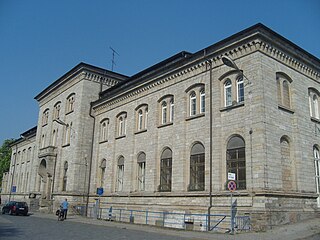
Weißenfels station is the station of Weißenfels in the German state of Saxony-Anhalt. It lies at the junction of the Halle–Bebra and the Weißenfels–Zeitz railways.

























